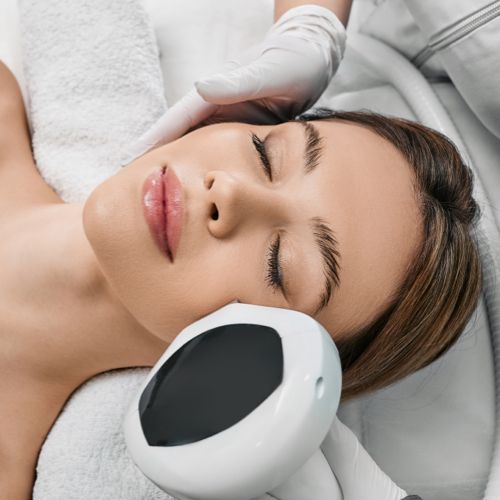REDUCE SIGNS OF AGING OR REMOVE UNWANTED HAIR
Intense Pulsed Light Treatment
Intense-Pulsed Light (IPL) is very similar to laser treatments in that it uses light energy as a cosmetic skin treatment. Unlike lasers, however, IPL releases many different wavelengths of light to stimulate or treat various issues. This non-invasive and non-ablative treatment can aid in reducing the signs of aging as well as in the removal of unwanted hair. Other uses include reducing the appearance of scars, lightening darker patches of skin, and improving the appearance of spider veins.

What skin conditions does IPL treat?
Some of the most common issues that can be treated and corrected through the use of intense pulsed light include:
- Acne and acne scarring
- Rosacea
- Redness/flushed appearance
- Sun damage/sun spots
- Hyperpigmentation, including liver or age spots and freckles
- Scars
- Spider veins
- Stretch marks
- Sun-damaged skin
- Signs of aging, wrinkles
- Birthmarks
IPL is also often used to remove unwanted hair or tattoos.
IPS – Frequently Asked Questions
How does Intense Pulsed Light Treatment work?
How effective is IPL?
How a patient responds to IPS is dependent on various factors, including their skin type and colour. IPS is known to work best on lighter-coloured skin tones. Everyone responds differently to IPL, and most patients will benefit from multiple rounds of treatment to achieve the desired results.
How should I prepare for my IPL treatment?
- Sunbathing and tanning beds
- Waxing
- Chemical peels
- Collagen injections
Immediately before and after therapy, we recommend avoiding applying any perfume or deodorant to the treatment area.
Also, it is advised to refrain from taking any aspirin, anti-inflammatory drugs, or herbal supplements before the procedure as these can contribute to the risk of bleeding.
Is the procedure painful?
What should I expect during recovery?
You may also experience a stinging sensation resembling that of a mild sunburn for 4 to 6 hours after IPL. We recommend applying a moist cloth or cool pack to help ease the stinging.
Swelling is a common occurrence post-treatment and can last for several days.
What should I do after the procedure?
After this time, we recommend moisturizing the treated area at least twice a day for a minimum of 3 months. We will gladly provide further advice on after-care products and precautions.